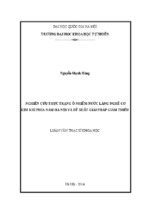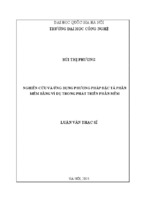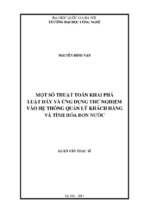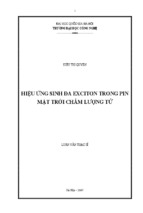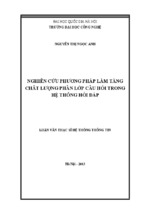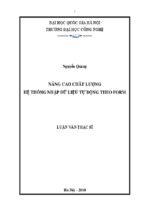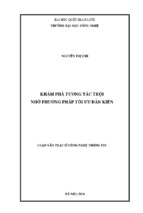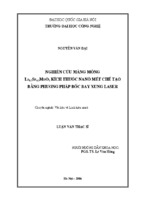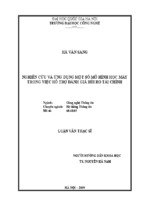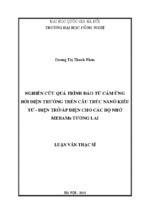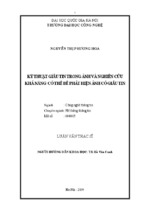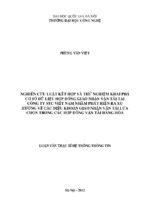..
國立屏東科技大學熱帶農業暨國際合作系
Department of Tropical Agriculture and International Cooperation
National Pingtung University of Science and Technology
博士學位論文
Ph.D. Dissertation
以企業跟顧客的觀點來探討大數據分析對電子商務的衝擊
Applying Big Data Analytics in E-commerce: Aspects of
Business and Customer
指導教授 Advisor: 廖世義博士(Shu-Yi Liaw, Ph.D.)
研究生 Student: 黎氏梅 (Le Thi Mai)
中華民國 107 年 06 月 01 日
June 1, 2018
摘要
學號:P10322019
論文名稱:以企業跟顧客的觀點來探討大數據分析對電子商務的
衝擊
總頁數:151 頁
學校名稱:國立屏東科技大學
系(所)別:熱帶農業暨國際合作系
畢業時間及摘要別:106 學年度第 2 學期博士學位論文摘要
研究生:黎氏梅
指導教授:廖世義 博士
論文摘要內容:
大數據分析應用已經在許多已開發國家中被各產業領域應用著。這
種新的分析工具提高了專家和研究人員對商業價值和企業挑戰的使用動
機。然而,目前研究在這部分較為缺乏以商業視角下評估大數據分析應
用的研究。本研究主旨在(1)應用大數據分析時,對公司的意義、企
業特色、企業價值和企業挑戰進行文獻回顧;(2)探索並確定應用大
數據分析在電子商務上對消費者反應的利弊影響;(3)評估知覺價值
維度和知覺風險的中介效應;(4)確定信任傾向的調節效果。通過使
用社會科學統計軟體和線性結構分析軟體進行數據分析,樣本回收越南
349 名受訪者之有效樣本。本研究從企業和客戶兩個角度進行分析。本
研究結果如下:
(1)該研究綜合了多種大數據分析概念,為大數據分析在電子商務公
司的應用提供更深入的見解。值得強調的是近年來與電子商務相關的大
數據分析興趣增加。 大數據分析在電子商務中的應用可以分為創建透明
度、發現需求和提高績效、細分市場、更好的決策、新產品或商業模式
創新等五個方面。這些應用程序帶來了許多商業價值,但也會對其他想
要應用大數據分析的電子商務業者帶來一些挑戰。
I
(2)研究結果發現訊息搜索、推薦系統、動態定價和客戶服務對消費
者反應有不同顯著的影響,整體而言,訊息搜索對消費者意向及改變消
費者行為的影響最大,而動態定價、推薦系統和客戶服務也對消費者意
向有顯著的影響,但消費者行為卻會降低。而另一方便,隱私、安全、
購物成癮和群眾效應對消費者反應有不同顯著的負面影響。具體而言,
購物成癮與群眾效應、隱私及安全相比,購物成癮對消費者意向及行為
都有具大的影響。因此不可否認的是,消費者正同時接收正面及負面的
影響。
(3)研究結果證實,功能和情感價值是大數據分析的積極性與消費者
反應之間關係的重要中介變數。但功能價值的中介效果與情感價值並無
顯著差異。這是一個重大的發現,現在的消費者不僅可以找到自己喜歡
的產品或服務,還可以享受在網上購物的趣味性。因此,如何有效地運
用大數據分析來促發消費者的功能價值和情感價值,這是給電子商務業
者的一個方向。
(4)研究發現,知覺風險不會調節大數據分析的負面因素與消費者反
應之間的關係。此外,客戶的信任傾向可以緩解大數據分析的負面因素
與客戶反應之間的關係及消費者感知到的風險。高信任傾向的消費者比
低信任傾向的反應更強烈。由於消費者對大數據分析應用的信任,因此,
當負面因素和知覺風險上升時,很容易對消費者行為有負面影響。
本研究有助於在以企業角度和消費者角度下增進對大數據分析應用
的理解,這提供給電商業者發展永續的消費者市場之重要作用。電子商
務可以依靠大數據分析來提升消費者行為,但過度使用可能會有一些負
面的影響。除此之外,本研究對未來的後續研究建議,理論和實踐方面
的挑戰進行了更廣泛的討論。
關鍵字:電子商務、大數據分析、消費者行為、知覺價值、知覺風險、
信任傾向
II
ABSTRACT
Student ID: P10322019
Title of Dissertation: Applying Big Data Analytics in E-commerce: Aspects
of Business and Customer
Total Page: 151 pages
Name of Institute: Department of Tropical Agriculture and International
Cooperation, National Pingtung University of Science
and Technology
Graduate Date: June 1, 2018
Degree Conferred: Doctoral Degree
Name of Student: Le Thi Mai
Advisor: Liaw, Shu-Yi, Ph.D.
The Contents of Abstract in This Dissertation:
The era of Big Data analytics (BDA) has begun in most industries within
developing and developed countries. This new analytics tool has raised
motivation for experts and researchers to study its impacts to business values
and challenges. However, there is shortage of studies which evaluate the
applications of BDA under business view and help to understand customers’
views towards the applications of Big Data analytic. This research aims to (1)
draw on a systematic review of the literature about definition, distinctive
characteristics, business values and challenges of a company when applying
Big Data analytics, (2) explore and determine the pros and cons of applying
Big Data analytics that affects customers’ responses in an e-commerce
environment, (3) evaluate the mediation effect of perceived value’s
dimensions and perceived risk, (4) determine the moderation effect of trust
propensity. Data analyses were conducted by using the statistical package for
social sciences and analysis of moment structures software in useful sample
of 349 respondents in Vietnam. Two aspects as business and customer views
are reviewed, explored, discussed in this study.
III
The major findings include:
(1) The study synthesized diverse BDA concepts that provide deeper
insight about application of BDA for e-commerce firms. It is highlight that
the increase in interest related to BDA in e-commerce in recent years. BDA
applications in e-commerce can be divided into five aspects like as creating
transparency, discovering needs and improving performance, segmenting
market, better decision making, new product or business model innovation.
These applications bring many business values but also raise some challenges
when e-firms want to apply BDA.
(2) The findings found that information search, recommendation system,
dynamic pricing, and customer services had different significant positive
effects on customers’ responses. Specifically, information search had a
highest significant influence on customers’ intention and improved
customers’ behavior. Following by dynamic pricing, recommendation system
and customers’ service also had significant impact on customers’ intention but
decreased customers’ behavior. On another hand, privacy and security,
shopping addiction, and group influences were found to have different
significant negative effects on customers’ responses. Specifically, shopping
addiction had a drastic change from intention to behavior compared to group
influences and privacy and security. It cannot be denied that customers
receive positive and negative factors at the same time.
(3) The results confirmed that functional and emotional values play
mediating roles between positive of applying BDA and consumers’ responses.
However, there weren’t significant different between mediator effect of
functional value and emotional value. This finding highlights the notification
that customers nowadays not only find their products or services but also seek
enjoyment when online shopping under Big Data era. Therefore, e-firms
should increase perceived value based on creasing equally functional and
emotional values.
IV
(4) The study found out that perceived risk don’t act mediate the
relationship between negative of applying BDA and consumers’ responses.
Besides, customers’ trust propensity was found to moderate the relation of
negative factor of applying BDA to customers’ responses and perceived risk
to customers’ responses. High trust propensity participants reported stronger
responses than those with low trust propensity. It due to customers’ trust on
new applications of BDA, hence, it is easy to influence on customers as their
negative response when negative factor and perceived risk are rising.
This study contributes to improve understanding of applications of Big
Data Analytics under business view and customer view. This could play an
important role to develop sustainable consumers market. E-vendors can rely
on Big Data analytics but over usage may have some negative applications.
Besides that, the research also broader discussion regarding future research
opportunities, challenges in theory and practice.
Keywords: E-commerce, Big Data Analytics, Customers’ Responses,
Perceived Value, Perceived Risk, Trust Propensity
.
V
ACKNOWLEDGEMENTS
This study has been carried out at the Department of Tropical
Agriculture and International Cooperation (DTAIC), National Pingtung
University of Science and Technology (NPUST), Taiwan. This is the outcome
of knowledge that I received from this university, my continuous efforts to
learning, and consistent guidance of my advisor.
Firstly, I would like to express my sincere gratitude to my advisor,
Professor Shu-Yi Liaw for continuous support of my Ph.D. study and related
research. He has given me valuable guideline, patience, assistance, motivation
and inspiration during Ph.D. time. His intellectual direction and critical
reviews of research works helps me all the time and find a right tract towards
the successfully competition of this dissertation. He is the best teacher I have
met.
Besides my advisor, I would like to thank the rest of my advisory
committee: Dr. Shi-Jer Lou, Dr. Rong-Fang Chen, Dr. Shih-Wei Chou, and
Dr. Pei-Chen Sun, for their insightful comments and encouragement.
My sincere thanks also goes to Dr. Nguyen Tuan Anh who encourage
me to join Ph.D. program. Many thanks to Dr. Joey Lee, Dr. Henry Chen and
other faculties who provided for their encouragement and supports during my
study. I would like to thank Barbara, Sylvia (OIA), Sophia, Joanna and all
DTAIC staff, Yang Ya-Chu, Lin Yi-Ru and other staff of computer center for
their assistants.
I thank my fellow classmates for the discussions and fun time we had.
Also thank my international friends Mediana Purnamasari (Indonesia), Mr.
Chuang-Yeh Huang (Johnson), Mr. Edgardo, Caleb Milk Breria (P&G),
Miguel, Michael Qwanafia Bilau (Solomon Islands), Rudra (Nepal), Stanley,
Jimmy, Adam, Guo Wei-Peng and other my friends for their support during
VI
the entire study. Thanks to Vietnamese student association members and the
time we have fun activities together.
I would like to thank NPUST and Chung Hwa Rotary Education
Foundation for providing me the scholarship to pursue my doctoral degree.
Last but not the least, I extremely grateful to my family, my boyfriend
and my relatives who have always given me encouragement and support to
finalize my study in abroad.
VII
TABLE OF CONTENTS
摘要............................................................................................................................. I
ABSTRACT ............................................................................................................ III
ACKNOWLEDGEMENTS .................................................................................. VI
TABLE OF CONTENTS ................................................................................... VIII
LIST OF TABLES ................................................................................................ XII
LIST OF FIGURES ............................................................................................ XIV
CHAPTER I. INTRODUCTION ........................................................................... 1
1.1. Background of the Study ..................................................................................... 1
1.2. Statement of the Problem .................................................................................... 2
1.3. Objectives of the Study ....................................................................................... 3
1.4. Contribution of the Study .................................................................................... 4
1.5. Definition of the Operation Terms ...................................................................... 5
1.6. Research Flowchart ............................................................................................. 6
1.7. Research Systematic Discussion ......................................................................... 8
CHAPTER II. LITERATURE REVIEW ........................................................... 11
2.1. Concept of Big Data in E-commerce Environment .......................................... 11
2.1.1. Big Data Analytics in the E-Commerce Environment ............................... 11
2.1.2. Big Data’s Distinctive Characteristics ........................................................ 13
2.1.3. Types of Big Data Used in E-commerce .................................................... 18
2.2. Big data analytics in E-commerce: Aspect of business .................................... 22
2.2.1. Literature Review Research Approach ....................................................... 23
VIII
2.2.2. Business Values of Applying Big Data Analytics for E-commerce
Firms .......................................................................................................... 27
2.2.3. Challenges of Applying Big Data Analytics in E-commerce ..................... 30
2.3. Big data analytics in E-commerce: Aspect of Customer .................................. 34
2.3.1. Positive Factor of Applying BDA on Customers’ Responses .................... 35
2.3.2. Negative effects of applying Big Data analytics on customers’
responses .................................................................................................... 40
2.3.3. The Mediating Role of Perceived Value and Perceived Risk .................... 42
2.3.4. The Moderating Effect of Individual Trust Propensity .............................. 46
2.3.5. Behavior Consumer Responses Hierarchy Models .................................... 47
CHAPTER III. RESEARCH METHODOLOGY.............................................. 49
3.1. Research Model and Research Hypotheses....................................................... 49
3.1.1. Mechanism of Applying Big data Analysis and Customers’ Responses ... 49
3.1.2. Perceived Value as the mediator for Positive Factor of Applying BDA
and Customers’ Responses ........................................................................ 50
3.1.3. The Mediating Role of Perceived Risk and Moderating of Trust
Propensity .................................................................................................. 52
3.2. The Operational Definition and Measurement Design ..................................... 55
3.3. Research Type ................................................................................................... 60
3.4. Pilot Test............................................................................................................ 61
3.5. Sample Size ....................................................................................................... 62
3.6. Data Type and Data Collection Method............................................................ 63
3.6.1. Data Type .................................................................................................... 63
3.6.2. Data Collection Method .............................................................................. 63
3.6.3. Data Collection Procedure .......................................................................... 64
3.7. Data Analysis Techniques ................................................................................. 65
IX
3.7.1. Descriptive Statistics Analysis.................................................................... 65
3.7.2. Reliability and Content Validity Analysis .................................................. 65
3.7.3. Comparing Mean Test................................................................................. 66
3.7.4. Exploratory Factor Analysis ....................................................................... 67
3.7.5. Structural Equation Model .......................................................................... 68
3.7.6. Mediation Test ............................................................................................ 71
3.7.7. Moderation Test .......................................................................................... 72
CHAPTER IV. RESULTS AND DISCUSSION ................................................. 74
4.1. Descriptive Analysis and Mean Comparison .................................................... 74
4.1.1. Descriptive Analysis ................................................................................... 74
4.1.2. Mean Comparison ....................................................................................... 75
4.2. Reliability Analysis ........................................................................................... 76
4.3. Study I-Explore Positive and Negative Effects on Customers’ Responses ...... 78
4.3.1. Exploratory Factor Analysis ....................................................................... 78
4.3.2. Measurement model .................................................................................... 80
4.3.3. Structural equation model ........................................................................... 82
4.3.4. Discussion and Sub-conclusion .................................................................. 84
4.4. Study II-Evaluating the mediation effects of perceived value’s dimensions
on relationship between PF and CR .................................................................. 88
4.4.1. Measurement Model ................................................................................... 88
4.4.2. Structural Equation Model .......................................................................... 90
4.4.3.Discussion and Sub-conclusion .................................................................... 93
4.5. Study III-Evaluating the Mediation Effects of PV and the Moderating of TP . 95
4.5.1. Measurement Model ................................................................................... 95
4.5.2. Structural Equation Model .......................................................................... 97
X
4.5.3. Examining Moderating Effects ................................................................. 100
4.5.4. Discussion and Sub-conclusions............................................................... 104
CHAPTER V. CONCLUSIONS AND RECOMMENDATIONS ................... 107
5.1. Conclusions of Research................................................................................. 107
5.2. Recommendations........................................................................................... 110
5.3. Limitations and Future Studies Recommendation.......................................... 113
REFERENCES ...................................................................................................... 115
APPENDICES ....................................................................................................... 137
Appendix A. Big Data analytics (BDA) applications in e - commerce ................ 137
Appendix B. QUESTIONNAIRE (English Version) ............................................ 139
Appendix C. QUESTIONNAIRE (Vietnamese Version) .................................... 145
Biographical Sketch ............................................................................................... 150
XI
LIST OF TABLES
Table 1. 5Vs of Big Data Characteristics in business analytics...................... 16
Table 2. Types of big data using in E-commerce .......................................... 20
Table 3. Big Data analytics (BDA) applications in e - commerce.................. 26
Table 4. Perceived value’ dimensions............................................................. 44
Table 5. Dimensions and indicators of customers’ responses ........................ 56
Table 6. Dimensions and indicators of positive factor of applying BDA....... 57
Table 7. Dimensions and indicators of positive factor of applying BDA....... 58
Table 8. Dimensions and indicators of perceived value ................................. 59
Table 9. Dimensions and indicators of perceived risk .................................... 60
Table 10. Assessing Reflective Measurement Models ................................... 70
Table 11. Demographic descriptive (n = 349) ................................................ 75
Table 12. T-test results by gender and survey items ....................................... 76
Table 13. Anova results by experiences.......................................................... 76
Table 14. Reliabilities among the variables .................................................... 77
Table 15. Correlation among variables ........................................................... 79
Table 16. Varimax-rotated component analysis factor matrix........................ 79
Table 17. Standardized factor loadings, CR and AVE of the model. ............. 80
Table 18. The latent variable correlation matrix: discriminant validity ......... 81
Table 19. Measurement model fit indicates .................................................... 81
Table 20. Results of regression ....................................................................... 83
Table 21. Reliability and validity of the constructs ........................................ 89
Table 22. The latent variable correlation matrix: Discriminant validity. ....... 89
Table 23. Measurement model fit indicates .................................................... 90
Table 24. Path comparison of indirect effects................................................. 92
Table 25. Reliability and validity of the constructs ........................................ 96
Table 26. The latent variable correlation matrix: Discriminant validity. ....... 96
Table 27. Measurement model fit indicates .................................................... 97
Table 28. Mediation effect of perceived risk .................................................. 99
Table 29. T-Test between trust propensity groups........................................ 100
XII
Table 30. Relationship between NF and CR, moderator effect by TP ......... 102
Table 31. The finding of hypothesis analysis ............................................... 108
Table 32. Future research questions for BDA in e-commerce...................... 114
XIII
LIST OF FIGURES
Figure 1. Conceptual Framework of the research ............................................. 8
Figure 2. The ease of capturing big data’s value, and the magnitude of its
potential, vary across sectors. .......................................................... 12
Figure 3. Characteristics and processing of Big Data ..................................... 14
Figure 4. Selection criteria and evaluation framework ................................... 22
Figure 5. Distribution of articles by year. ....................................................... 25
Figure 6. The evolution of consumer behavior ............................................... 35
Figure 7. Model 1-Exploring and determining the mechanism of applying
BDA ................................................................................................. 50
Figure 8. Model 2-The mediating role of perceived value ............................. 52
Figure 9. Model 3-The mediating role of perceived risk ................................ 54
Figure 10. A conceptual diagram of a simple mediation ................................ 71
Figure 11. A conceptual diagram of a simple mediator .................................. 72
Figure 12. A simple moderation model depicted as a statistical diagram. ..... 72
Figure 13. A combing mediation and moderation model depicted as a
statistical diagram ............................................................................ 73
Figure 14. A simple combing mediation and moderation conceptual model . 73
Figure 15. The results of the research model .................................................. 82
Figure 16. Results of regression ...................................................................... 84
Figure 17. The results of direct effect ............................................................. 90
Figure 18. The results of mediation model ..................................................... 91
Figure 19. The results of direct effect ............................................................. 97
Figure 20. The results of mediation model ..................................................... 99
Figure 21. The results of moderating model ................................................. 101
Figure 22. Moderator effect of TP in relation between NF and CR ............. 103
Figure 23. Moderator effect of TP in relation between PR and CR ............. 104
XIV
CHAPTER I
INTRODUCTION
1.1. Background of the Study
With increasing advancement of internet technology, increasing
amounts of data are streaming into contemporary organizations. Data is
getting bigger and more complicated because it is continuing to be generated
from many devices and more sources as mobile phones, personal computers,
government records, healthcare records, social media, etc. An International
Data Cooperation report estimated that the world would generate 1.8
zettabytes of data (1.8 × 1021 bytes) by 2011 (Gantz and Reinsel, 2011). By
2020, this figure will grow up to 35 zettabytes or more. The Big Data era has
arrived. Why
do researchers and
practitioners
be
interested
in
understanding about the impacts of Big Data analytics? The simple reply
to this critical question is because Big Data enables to bring potential
applications. Big Data applications can help organizations; the government
predicted the unemployment rate, the future trend for professional investors,
or cut spending, stimulates economic growth, etc. For health care, Big Data
can help to predict impact trend of a certain disease. One of the most
conspicuous examples of Big Data for health care is Google Flu Trend (GFT).
In 2009, Google has used Big Data to analyze and predict trends influence,
spread of H1N1 flu. Trend which Google drawn from the search keywords
related to the H1N1 has been proven to be very close to the results from flu
independent warning system Sentinel GP and Health Statistics launched. The
GFT program was designed to provide real-time monitoring of flu cases
around the world based on Google searches that match terms for flu related
activity. For e-commerce firms, the inject Big Data analytics into their value
chain value 5-6% higher productivity than their competitors (McAfee et al.,
2012).
1
Big Data is generating remarkable attention worldwide. There are some
definitions of Big Data term. Manyika et al. (2011) defined that Big Data as
a dataset with a size that can be captured, communicated, aggregated,
stored, and analyzed. Another definition is that Big Data are generated from
an increasing plurality of sources including internet clicks, mobile
transactions, user generated content and social media as well as purposefully
generated content through sensor networks or business transactions such
as customer information and purchase transactions (George et al., 2014).
Big Data has various forms are divided into two main forms as structured data
and unstructured data. Big Data owns distinctive characteristics (volume,
variety, velocity, veracity and value) so it can easily distinguished from the
traditional form of data used in analytics.
Each industry moves a step closer into understanding the world of Big
Data from how it is being applied to solve a lot of our problems. Most
industries are still estimating whether there is value in implementation of Big
Data, while some industries have applied Big Data analytics already. There
are applications of Big Data in top ten industry verticals as banking &
securities, communications, media& entertainment, healthcare providers,
healthcare providers, education, manufacturing & natural resources,
government, insurance, retail & wholesale trade, transportation, energy and
utilities. Even though, Big Data specific challenges will have to face but it is
to be noted that Big Data implementation has been encountered by the
industries in these sectors.
1.2.
Statement of the Problem
The activity of retailing and wholesaling shapes both our economy as
well as our daily life. Consumers and businesses buy products and services
every according to their needs and preference. The retail and wholesale
sectors contribute significantly in national economy. In today competitive and
complex business world, the company needs to rely on the data-structured and
new type of data-unstructured or semi-structured to back up their decisions.
2
BDA can bring benefits for e-vendors by improving market transaction cost
efficiency (e.g. buyer-seller transaction online), managerial transaction cost
efficiency (e.g. process efficiency) and time cost efficiency. DBA also
enables e-commerce firms to use data more efficiently, driver a higher
conversion rate, improve decision making and empower customers. However,
DBA is new method for e-commerce vendors. Therefore, they have to face
some challenges when applying BDA.
In addition, an increasing amount of published articles or books has
focuses on DBA applications in e-commerce in recent years. However, the
literature still remains largely anecdotal and fragmented. The research which
provides dimensions and applications of Big Data analytics in e-commerce
are limited. Therefore, this research is to identify different conceptual
dimensions of Big Data analytics in e-commerce and their relevance to its
characteristics, different type of data and state business value and challenges.
From there, it can help the e-commerce enterprises enhanced business value
and better respond to challenges of BDA applications.
Furthermore, Big Data analytics applications were used in many
industries. Specifically, Big Data enables merchants to track each user’s
behavior and connect the dots to determine the most effective ways to convert
one-time customers into repeat customers in the e-commerce context. Hence,
the studies which determine the positive and negative of applying BDA and
evaluate the customers’ responses under Big Data era are needed.
1.3. Objectives of the Study
Although an increasing amount of published materials has focused on
practitioners in this domain. But it remains largely fragmented. There is a
paucity of research that provides a general taxonomy from which to explore
the dimensions and applications of big data analytics in e-commerce. This
research intends to provide a thorough presentation of the conceptual
dimensions of big data in e-commerce and their relevance to business values
3
and challenges. The extant literature review shows that Big Data analytics
could allow an e-commerce firm to achieve a range of benefits and face some
difficulties. Besides, this research focuses on the impact of positive and
negative mechanism of Big Data analytics to customers’ responses in B2C ecommerce environments using application of Big Data analytics. The specific
objectives are:
i. To draw on a systematic review of the literature about business values and
challenges of a company when it applies Big Data analytics.
ii. To explore variables this has positive and negative effects on customers’
responses.
iii. To evaluate the mediation effects of perceived value’s dimensions on
relationship between positive factor of applying BDA and customers’
responses
iv. To evaluate the mediation effect of perceived risk on relationship between
negative factor of applying BDA and customers’ responses and moderation
effect of trust propensity.
1.4. Contribution of the Study
This research intends to provide a thorough representation of the
meaning of Big Data in the e-commerce context by drawing on a systematic
review of the literature about business value and challenges of a company
when it applies Big Data analytics and finding the mechanisms of applying
Big Data analytics to customers’ responses.
The study would suggest important implications in enhancing business
values and minimum the challenges of applying Big Data analytics. Evendors could know what they need to prepare if they want to apply BDA in
their system. Identifying the factors of mechanisms of applying BDA
affecting on customers’ responses, it would help for companies to understand
4
their customers’ behavior when they apply BDA and customers also can
understand themselves under Big Data era.
1.5.
Definition of the Operation Terms
There are some keywords or operational terms used in this study which
are needed to define as following:
1. E-commerce: E-commerce is the activity of buying or selling of products
and services online or over the internet. Electronic commerce draws on
technologies such as mobile commerce, electronic funds transfer, supply
chain management; Internet marketing, online transaction processing,
electronic data interchange (EDI), inventory management systems, and
automated data collection systems (Wikipedia).
2. Big Data: Big data is a data set that is so voluminous and complex that
traditional data processing, applications software is inadequate to deal with
them. Big Data is similar to ‘small data ‘, but bigger in Size (Wikipedia).
3. Big Data Analytics (DBA): Big data analytics is where advanced analytic
techniques operate on big data sets. Hence, big data analytics is really about
two things - big data and analytics - plus how the two have teamed up to
create one of the most profound trends in business intelligence (BI) today
(Russom, 2011).
4. Structural Equation Modeling (SEM): SEM is multivariate technique
combining aspects of factor analysis and multiple regression that enables the
researcher to simultaneously examine a series of interrelated dependence
relationships among the measured variables and latent constructs as well as
between several latent constructs (Hair, 2010).
5. Reflective Measurement Model: a measurement model specification in
which it is assumed that the indicators are causes by the underlying construct.
6. Positive factor: Variables related to positive factor of positive impact of
BDA application such as information search, recommendation system,
dynamic pricing and customer’ services were considered in the analysis.
5
- Xem thêm -

